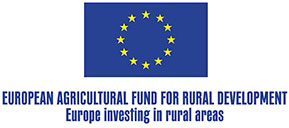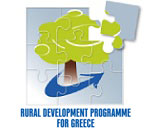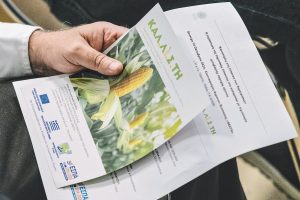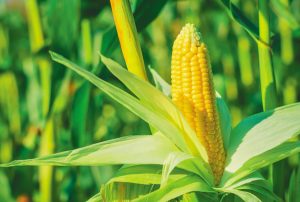Dr Eleftherios Evangelou: Site-specific nitrogen fertilisation

DR ELEFTHERIOS EVANGELOU: SITE-SPECIFIC NITROGEN FERTILISATION
Dr Eleftherios Evangelou, agronomist – edaphologist, researcher at the Institute of Industrial and Forage Crops of the ‘Dimitra’ Hellenic Agricultural Organisation (EL.G.O. ‘Dimitra’), talks with Agro.tec about the new project of the KAL.LI.S.TI Operational Group of Measure 16 of R.D.P. 2014-2022, which commenced this period and concerns site-specific fertilisation of crops with nitrogen and experiments in the field on maize plantings.
Fertilisation is necessary for crop growth. However, the continuous increase in fertiliser prices and EU guidelines for more environmentally friendly and targeted applications have led researchers to search for the best ways to fertilise soils. Dr Eleftherios Evangelou, agronomist – edaphologist, researcher at the Institute of Industrial and Forage Crops of the ‘Dimitra’ Hellenic Agricultural Organisation (EL.G.O. ‘Dimitra’), talks with Agro.tec about the new programme that commenced this period and concerns site-specific fertilisation of crops with nitrogen and experiments in the field on maize plantings.
Interview with Katerina Ladopoulou
Agro.tec: What is the difference between the conventional nitrogen fertilisation currently performed on crops and site-specific fertilisation that the project aims for?
– Nitrogen fertilisation in crops is currently done under the assumption that plant nutrient requirements are the same throughout the field. But there are cases when producers, aware of a “less fertile” part of the field, set the nitrogen dose for fixed-dose fertiliser spreaders to meet the increased needs of that specific part, while being aware that the rest of the field will be overfertilised.
This has financial consequences, as the producer will spend more nitrogen than the crop requires, and it will also have environmental consequences, because nitrogen that is not used by plants may escape into the environment.
Today we know that the crop nitrogen requirements are not constant throughout the field, and, correspondingly, optimal nitrogen fertilisation differs spatially, often significantly, in each field. Site-specific fertilisation refers to a variable nitrogen supply in a field, according to the actual differing needs of the plants in that space.
Agro.tec: How can site-specific fertilisation with the variable nitrogen supply technology that you are currently developing in the programme you are heading help with sound corn crop management?
–The ‘Site-specific corn fertilisation using variable nitrogen supply technology with high spatial distinction capabilities’ project, titled ‘KAL.LI.S.TI’, is being implemented in the context of action II ‘Implementation of the operational plan of the operational groups for environmental protection and adaptation to climate change’ of sub-measure 16.1 – 16.5 of Rural Development Programme (RDP) 2014 – 2020.
The project concerns a variable supply of liquid nitrogen in surface fertilisation of corn and is coordinated by Dr Stamatis Stamatiadis, researcher at the Goulandris Natural History Museum, while the Institute of Industrial and Forage Plants of the ‘Dimitra’ Hellenic Agricultural Organisation (EL.G.O. ‘Dimitra’), the THES.GI agricultural cooperative, and the Pro depot company are participating as partners.
The project will use the same philosophy of the variable granular fertiliser delivery system that was developed in the ‘Fatima’ Horizon 2020 European project with very encouraging results.
The original system created for the needs of the KAL.LI.S.TI project uses liquid fertiliser that will allow us to increase the speed of application, reduce manufacturing and maintenance costs, and afford us foliar application capabilities.
Agro.tec: What is variable nitrogen fertilisation supply and how will it be performed in the project?
– Variable nitrogen fertilisation refers to the differentiated fertilisation of the field according to the needs of plants, which differ spatially and temporally. Very briefly, multispectral sensors calculate at very high resolutions (40Hz) vegetation indicators directly related to the robustness and the concentration of nitrogen in plants. This information is sent to a data logger that incorporates a special algorithm, which converts the indicator data into a nitrogen fertilisation dose, taking into account distinctive information for each field.
The fertilisation dose information is sent to a special controller that controls pump flow to apply differentiated amounts of liquid nitrogen through small pipes or sprinklers, depending on the crop. The entire process is carried out in real time, as the producer’s tractor moves through the field. Liquid nitrogen is placed in the tank of the producer’s sprayer and the whole system is adapted, before fertilisation, externally to the sprayer, on any tractor/sprayer combination, regardless of what type and how old it is.
Agro.tec: Why did you choose corn for this programme?
– Corn is one of the most nitrogen-demanding crops, and production costs related to nitrogen fertilisation are very high. Also, low effectiveness fertilisation on corn can cause significant nitrogen losses to the environment, with severe consequences.
Agro.tec: What are the advantages and disadvantages of the method you use?
– The main advantage of site-specific fertilisation is to increase the efficiency of Nitrogen use, as it detects the changing needs of plants, while implementing variable fertiliser doses. As a result, the total amount of nitrogen applied is reduced, along with significant environmental benefits from reduced likelihood of nitrogen losses to the environment, as well as a reduced carbon footprint, as the carbon footprint of nitrogen fertiliser production is one of the highest in agriculture.
The original system we use ensures a very high resolution of even up to 1-2m and is ideal for the relatively small lots of Greek agriculture. The algorithm that determines the fertilisation dose in relation to the sensor values was developed following numerous field experiments in America, by the team of our key partner and global pioneer in the dissemination of differentiated fertilisation, Dr James Schepers. This algorithm has significant advantages, the most important being easy and fast calibration of the system according to the specific conditions of each field.
From left to right: Dr Stamatis Stamatiadis, from the Goulandris Natural History Museum, Antonis Glampedakis, from ProDepot, Avraam Papadopoulos, cooperative producer, Dr Eleftherios Evangelou, from the Institute of Industrial and Forage Plants of the ‘Dimitra’ Hellenic Agricultural Organisation.
However, attention should be paid to irrigation, which should not be excessive, because it may remove nitric nitrogen after fertilisation to ground levels that are deeper that the root layer.
Agro.tec: What have experiments in the field shown so far?
– The first results from the project are expected in the coming months, as the first application took place in late May. However, results from the variable nitrogen supply system with granular fertiliser after 3 years of field experiments, report: a) a significant increase in the efficiency of fertiliser use in winter wheat, cotton and, maize cultivation, and b) reductions in the amount of nitrogen fertilisers ranging from 20 to 40%, without any decrease in yields compared to the conventional fertilisation by the producer.
These results are accompanied by a significant reduction in fertilisation costs and the nitrate nitrogen remaining in the soil after harvest.
Agro.tec: How can this form of corn fertilisation be put into practice and how expensive is it?
– The confirmation of the previous results of differentiated fertilisation in the experiments of this project will encourage producers, especially co-operative members, to seriously consider the benefits of site-specific fertilisation. The financial benefit will certainly be an important incentive, especially when fertiliser prices have increased significantly. Furthermore, the state is also expected to subsidise similar practices as environmentally friendly actions in the near future.
We can’t calculate what the cost of the prototype system on the market may be, but it is not expected to exceed 15,000 Euros, making it an affordable solution for producer groups and cooperatives, which can play an important role in spreading a new philosophy in nitrogen fertilisation of crops, a philosophy that is closer to reality.
Agro.tec: What is the duration of the programme?
– The programme started in December 2022 and will continue until December 2024, including field experiments in real conditions for two consecutive growing seasons, in collaboration with THES.GI cooperative producers.
The interview was printed in the May – June 2023 issue that is currently available.








